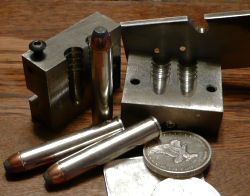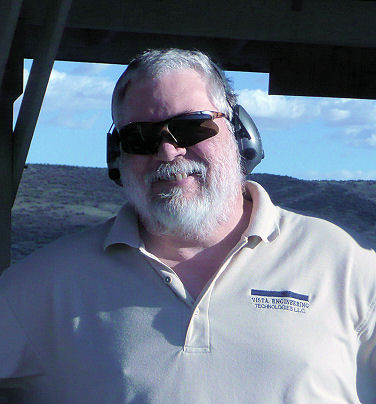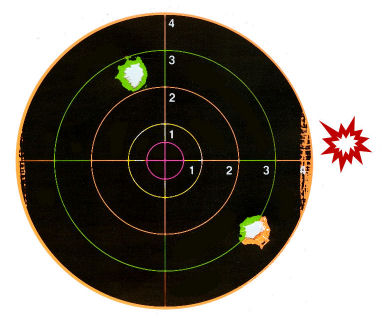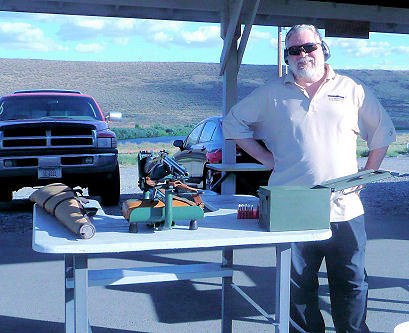Dare I Shoot?
| Silver Bullet Pages | |
|---|---|
|
|
|
Dare I shoot one?

When Tom Lentz delivered a nice box of loaded silver bullets to me, we all joked about how I'd probably kill myself trying to shoot them. Ha ha. As I held them in my hands, I was having some second thoughts. The .444 Marlin isn't a toy -- it's intended for killing big game animals, and here I was holding some home-made experimental ammunition. There's an old joke that says the most common last words of a redneck are, "Hey, Bubba, hold my beer and watch this!." Suddenly I was feeling very much a redneck, so I called my friend to Kyle to hold my beer. Since I don't drink, he wasn't able to help, but he did offer to come to the shooting range and hold my hand.

I drove out to the gun range, bringing the silver bullets and my trusty Marlin. As I drove up to the gates, there was Kyle with a smile a mile wide, just unlocking the gates. Kyle Roberson is a long-time friend. Hey, only a real buddy will offer to clean up any evidence of malfeasance and make your body presentable for your wife if things go wrong! He'd brought his handy chronometer, and a couple of serious gun guys Brian and Matt, who just wanted to meet the crazy man (by which I assume they meant me). Much to my dismay, introductions were soon over, and it was time to get down to business.
 |
| Here's the Setup. The Marlin Guide Gun is on a rest is to help stabilize it, and you can see both the factory loads (blue box) and the silver bullets (red box) ready to shoot. |
We Decided to check velocity and accuracy at some ridiculously close ranges. We didn't have a lot of silver bullets to burn, and I wanted to get as much data as I could. We set up a target just behind the chronometer at an embarrasing range of three meters, and sent a couple of factory bullets down range just to make sure that the gun was working and the chronometer was picking them up properly. Then I levered in the first of the silver bullets. Kyle and the guys moved back a respectful distance, and I contemplated the blue sky and barren landscape for a minute. Hey, if I'm going to die, I want to be properly appreciative of this world before I go. Then I grabbed hold of the gun, took aim, and squeezed the trigger.
Boom! The recoil was noticably less than the factory ammunition I'd been shooting a little earlier. I quick glance indicated the gun hadn't exploded, and I was still alive. A second glance showed another hole through the target, right where I'd been pointing. That little hole had been made by a silver bullet, and the chrono said it had been going just a little slower than the lead bullets, but still plenty fast to be deadly. We kind of savored the moment for about ten seconds, then took another shot to see if our good luck would hold. Soon there was yet another neat little hole in the target, and the chronometer had clocked a second silver bullet. These things worked!
OK, so they're dangerous at less than ten feet, big deal. What about down-range performance? Dr. Kevin Jaansalu, ballistics genius extraordinaire, was wating for some good performance data back at Montana Tech so he could build a complete mathematical model of silver bullet's performance. We had an idea of how fast these bullets were going near the muzzle, but how quickly were they slowing down? More importantly, could we hit the broad side of a barn with them?
Against Kyles better judgement (or more accurately, despite his protests), I moved his chronometer out to fifty yards, and jammed a well-used target that was laying around into the dirt behind it. I fired two factory bullets over the chronometer followed by two silver bullets. When we went down range to inspect the damage, there were only two readings on the chronometer. Were they the lead bullets, or the silver ones? Since the target had about thirty holes in it before I started shooting, we weren't able to tell where, exactly, my bullets had struck. Kyle was pretty sure the silver bullets had completely missed the target, while I was thinking that the silver color may have been too light for the chronometer to easily detect (see, I'm an optimist!). The bottom line is that haste makes waste, and by shooting several bullets at once I'd lost the ability to get any solid data.
I put up a nice clean target behind Kyles chronometer, again ignoring his good-natured kidding about my marksmanship being a risk to everyone around me. With Brian and Matt's help I managed to pry his fingers off of the expensive machine, and escort him back behind the firing line. I was a little worried about where those silver bullets might be going, but this was for science, darn it. So, I send another chunk of supersonic silver down range.
The chronometer jumped like a startled rabbit, and something flew skyward a good distance before fluttering back to earth. On closer examination Kyle's chronometer was found to missing one of the solar shields, and the right-hand support rod was now two twisted pieces of wreckage. There was a hole in the target about three inches right of center, and low. The chronometer had narrowly escaped being turned into scrap metal, and we unanimously decided to retire it from the field of battle while the damage was still repairable. Of course it hadn't managed to get a velocity reading on the bullet that nearly destroyed it.
 |
| Here's a scan of the target, shot from 50 yards. The rings are marked in inches, and I've indicated where the third bullet struck the tape. Not my best-ever group. |
Since I had a target with one hole in it, I decided to send a couple of additional bullets down range to see just how erratic they were. The second bullet hit high and right of center, and the next one missed the target completely. When I went to pull the target down, however, I could see a neat hole punched through the tape I'd used to hold the target to the backboard. The third bullet had struck far to the right, and a shade high.
In defense of the silver bullets, it should be noted that the Marlin is equipped with peep sights, which are great for rapid target acquisition, but not much for accuracy. It also sufferes from having me on the trigger. Even with factory loads, I don't do much better than a three-inch group with this gun.
These bullets aren't going to win any long-range accuracy tests, but they're good enough to be dangerous. I'm excited to do a little additional testing, and I'm pretty sure we can improve the accuracy. Unfortunately, Tom Lentz, who did all the reloading work, is moving. Due to unforseeable circumstances, the new house isn't done, and the reloading dies are all in storage for a while. Hopefully we'll be able to load some more bullets in the spring. In the interim, I've sent Dr. Jaansalu the minimal data we gained, and I'm saving my few remaining silver bullets for the history channel's werewolf special in Butte.
 |
| Here's another shot of Kyle, who was a great sport about me shooting his chronometer. Even though this was taken before that shot, he's still smiling, and we're still friends. |
Next: Shooting for the History Channel
